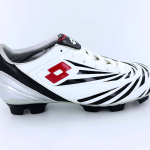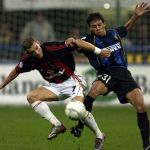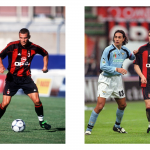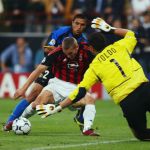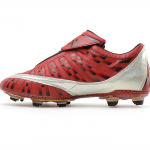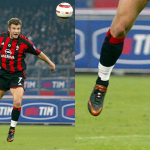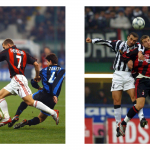
The years of Sheva and Lotto
How the golden age of the Ukrainian coincided with the rebranding operation that allowed the Italian brand to compete with Nike and adidas
January 16th, 2021
«A great champion of which we can boast the primogeniture and which has contributed to the visibility and prestige of the brand»
With these words that, on 16 March 2006, Andrea Tomat formalizes the divorce between Lotto and Andriy Shevchenko after six years in which the Italian brand had characterized the Ukrainian striker’s climb to the top of Italian and European football.
A week earlier, during the Champions League match between Milan and Bayern Munich, Shevchenko, author of a goal and an assist, had decided not to wear his "Sheva 7 Extreme" - with which he scored the 1-1 penalty in the previous match at Allianz Arena - using total black boots of another brand duly covered. The reason? The pains that the latest version of his signature boots caused to his tendons. So, three months before the World Cup in Germany and a few weeks after the launch of the futuristic "Zhero Gravity", the first visionary boot lacesless, Lotto decides to stop the relationship with his main athlete.
The story began in the summer of 2000. After his first season at AC Milan where he became Serie A top scorer as unbranded, Shevchenko in 2000/2001 season wears the legendary "Stadio" with the tongue folded outwards covering laces and the bright green of the logo to stand out on the black of the upper. The 24 goals - two in the sensational 6-0 against Inter - in 34 appearances, convince the company to recalibrate on him the rebranding strategy: during the 90s, Lotto had tied its name to iconic teams like AC Milan or Croatia that closes third in the 1998 World Cup - with Suker top scorer wearing the "Stadio"; now the brand decides to reposition itself on the new millennium’s market focusing on great players. And Shevchenko becames the signature athlete, chasing Nike and Ronaldo: in that period it’s released the "Sheva PU", the first brand’s signature boot, with which Shevenchenko scores an iconic goal against Juventus in San Siro.
Thanks to the futuristic layout, enhanced by the combination between the silver on the upper and the red on lines and fixtures, the model has immediately successful. But the communication strategy it’s also important: in an era in which Nike and adidas compete through aggressive television and multimedia campaigns, Lotto decides to occupy the advertising spaces of newspapers and sports magazines. Forget "The Cage Tournament": Lotto focuses on the power of the single image, on the combination of tradition and innovation that only photography can give, on what the snapshot of a single technical gesture can tell. There is no freestyle, there are no sounds and colors that characterize commercials increasingly noisy and exaggerated: there is only Sheva that runs, shots and scores on the Lotto posters. An immediate, direct, no-frills message that goes straight to the hearts of fans and fans: just like Shevchenko on the pitch.
During 2002/2003 Champions League run, Shevchenko wears the "Sheva Elite" in various colorways: maroon and silver against Real Madrid in group stage, red and white in quarterfinals and semifinals against Ajax and Inter, black and orange against Juventus in Manchester Final. Then, in January 2005, is released the "Sheva Gold", a limited edition to celebrate the 2004 FIFA Ballon d'Or winning. At that time Shevchenko is one of the most important players in the world and, thanks to his star power, in the season before the World Cup, the "team" Lotto can count on players like Cafu, Luca Toni, Mauro Camoranesi, Clarence Seedorf, Simone Perrotta. All of them with a customized model based on their characteristics: the Brazilian exterior will be, for years, an aficionado of the "Vento" with which he became world champion in 2002, while the three members of the italian teams and the Dutch become the main testimonials of the "Zhero Evolution".
In that years Lotto it’s a credible competitor of the sector’s giants who can afford showing off in other commercials - like this one of Rogan beer, in which Shevchenko wears the jersey of the Ukrainian national team with the Lotto logo on the sleeve - or launching the Italian response to Nike "Mercurial Vapor": the "Sheva Speed" with which, on 12 April 2005, scores a resounding goal in another Champions League derby, sadly passed to history due to the accidents on the stands, are the product of a cutting-edge and projected to the future company, able intercepting the trends and tastes of the single moment, reworking them in a unique, recognized and recognizable style and attracting some of the most important players in the world.
For this reason the divorce from Shevchenko before the World Cup, it’s a very negative turning point. The progressive downsizing of the brand - which, in the following years, will be able to retain some leverage almost exclusively thanks to Luca Toni - begins at that moment: it’s as if the difficulty in finding a "new Shevchenko", prevented to continue on that path of visionary and innovation that seemed traced. The testimonials retire, the models standardize, and Lotto can no longer measuring up to the challenge launched by Nike and adidas, seeing itself progressively ousted by PUMA, Under Armour, for a period even Reebok: all more careful in understanding how and where and with whom football was changing. Just like Lotto did at the beginning of the millennium betting on a young Ukrainian who didn’t have a pair of signature boots. Perhaps for this reason, on September 29, 2015, the official account tweeted to Sheva for his birthday, in memory of the times when both were on top of Italy, Europe, the world.








































.png)


.jpg)











.png)






























